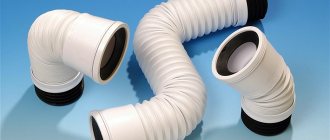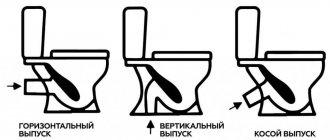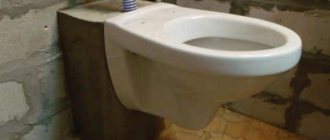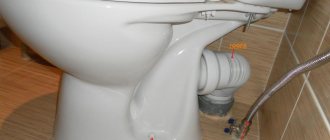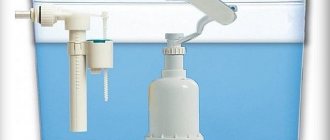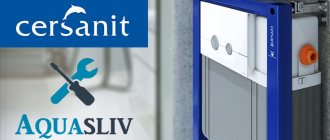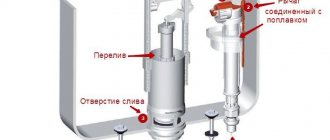Faulty plumbing causes a lot of inconvenience and is often a source of conflict with neighbors. If a toilet leaks, it spreads an unpleasant odor not only in the toilet, but throughout the entire apartment; furniture, household items, and clothes are saturated with it. Due to increased humidity in the bathroom, the floor and wall coverings are destroyed, and the ceilings of residents on the floor below are also leaking. Often the cause of a leak is poor-quality or incorrectly installed corrugation. This can happen due to the use of unskilled workers who use the cheapest materials.
In order to prevent the corrugation from leaking, it is necessary to ensure that it does not become clogged or filled with water.
Scheme of the corrugation device.
The corrugation is an accordion pipe that connects the neck of the toilet to the sewer hole. To make sure that it is not the toilet bowl (or tank) itself that is leaking, but its outlet, you just need to drain the water and see exactly where it is leaking. If the cause is, after all, corrugation, then the problem can be eliminated by repairing the tube or by replacing it. Before starting repairs, you need to find the place where the water was flowing from. There can be 2 options:
- the pipe has a rupture (or crack) and therefore flows;
- The connection of the corrugation with the sewer (or with the toilet bowl) is leaking.
Here's how to fix a folded sleeve:
- dry the crack with a hairdryer and seal it with a piece of rubber using waterproof glue;
- wrap the hole with a rag soaked in epoxy resin, having previously degreased the contact area;
- put an improvised plaster of bandage and cement mixture on the pipe;
- wrap the outlet tightly with a bandage coated with sanitary silicone.
All of the above methods will only help you forget about a leaking toilet for a while, since the corrugation is practically beyond repair.
The best solution would still be to replace the tube.
Installing corrugation on a toilet - subtleties and nuances
The process of installing a corrugation is very closely related to the installation of a toilet - you cannot install a toilet and then connect it to the sewer with a corrugation. Everything will have to be combined and done in a strictly defined sequence.
- To begin with, the corrugation must be pulled over the toilet outlet. It is very easy to put on, but nevertheless, careless movements can lead to damage to the product. If you smear the sealing rubber in the socket with soap, the corrugation will fit onto the socket easily, with minimal effort - in any case, you need to tighten it with a twist.
- Next, we move the toilet to the sewer socket and insert the corrugation into it, after which we position the pot in the desired position and mark its attachment points.
- We remove the corrugation from the sewer socket. We drill holes for fasteners in the floor and return everything to its place, inserting the corrugation into the sewer.
- Now, after a test flush, when you are convinced that there are no leaks, the toilet bowl can be thoroughly fixed to the floor. In principle, that’s all, but there is one subtlety - in order for the rubber to properly seal the connection between the corrugation and the old cast iron sewer, the socket of the latter must be very well cleaned of rust and old seal. There are no other nuances here, and you will not need any additional sealing of the seams with silicone. It is not needed here - silicone spoils the rubber over time, so you should completely forget about it.
To conclude the topic about why a toilet corrugation is needed and how it is installed, I will say a few words about replacing the old, leaky corrugation with a new one. Such repairs are carried out very simply, without even having to remove the toilet. First, squeezing the corrugation like a spring, the liner must be disconnected from the toilet. Then, accordingly, pull it out of the socket. The new corrugation is installed in the reverse order - first it is inserted into the socket, then it is compressed and pulled onto the toilet. This is where the superiority of corrugated pipes over rigid toilet connections lies. Yes, I completely forgot - such a trick is only possible if in the established position the corrugation is stretched and not compressed to the limit. This point should not be overlooked during the initial installation of a plumbing fixture.
Tools needed to replace the part yourself
To perform installation work you should prepare:
- additional fasteners to prevent sagging of the corrugation (for short and slightly stretched connections will not be needed);
- plumbing sealant - silicone sealant - for lubricating mating surfaces;
- a knife or similar tool for cleaning the pipes from dirt;
- rags.
Photo 1. SantekhMasterGel plumbing sealant for sealing threaded connections.
To install the corrugation, no special devices are required, so you only have to buy sealant; the rest can be found in the house.
Corrugation for toilet: advantages and disadvantages
If we compare the corrugation for a toilet flush with the old technology for connecting this plumbing fixture to the sewer system, then we can highlight at least a couple of global advantages.
- First of all, this is the speed of installation. If previously you had to wait for the sealant to harden, then in the case of a flexible outlet the toilet can be used immediately after connecting to the sewer.
- Versatility. The flexible corrugated outlet allows you to rotate the toilet bowl relative to the drain hole at almost 90 degrees in any direction. There is only one limitation for it - the outlet does not allow the toilet to be brought closer to the wall when installed directly. Well, there are other products of this type for this purpose.
- Reliability. It is ensured by a well-thought-out system of rubber seals. At such a connection, the joint leaks only in two cases - when the corrugation is installed incorrectly and when the sealing rubber dries out over time.
You can see what a corrugation for connecting a toilet is in this video.
This product also has disadvantages, which are caused not by the idea of the product itself, but by the quality of its manufacture - cheap products of this type can burst even before installation. This happens in the inept hands of a master, but it also happens due to the quality of the plastic. In general, you don’t need to buy cheap products, and everything will be fine.
Valve or drain pipe
Now let's decide whether a vacuum valve can completely replace a drain pipe. We will also break this question into two:
Is it possible to equip the sewerage system in a private house with a valve instead of ventilation? Is it possible to dismantle the sewer riser on the top floor of an apartment building above the cross or tee with your own hands and install a vent valve instead?
A private house
Installing a valve instead of ventilation is possible, but not advisable. Why?
- There is no escape from the draft created in the risers. The slightest violation of the tightness of the sewer - and the smells of sewage will begin to saturate the kitchen and bathroom. When ventilation is running, any gap between the plumbing fittings and the pipe socket will, on the contrary, draw air out of the corresponding rooms;
- When connected to a central sewer, the drain pipe facilitates ventilation of the manhole through the outlet. In particular, the methane content drops under the lid. The argument is not far-fetched: every year several people die from suffocation in a well;
- If you use a septic tank, its ventilation through the septic pipe will promote the activation of aerobic bacteria and, therefore, better processing of wastewater with a reduction in solid sediment and odors.
Apartment house
I strongly do not recommend disassembling the riser outlet onto the roof. Even with replacing the drain pipe with a vacuum valve. You see, the benefit from such a solution will only be the opportunity to make the cabinet above the toilet a little more spacious; but the righteous anger of the neighbors below, the housing organization and representatives of the municipality will fall on your head.
Why?
The mechanism in brief is:
- After dismantling the drain pipe and installing the valve, the ventilation of the riser will stop, but the draft in it will not go away. Meanwhile, the connections between washbasins and combs in most apartments are leaky. The sudden appearance of amber will arouse the interest of residents on the floors below you and a bunch of complaints to the housing office or management company;
- When a mechanic comes to a call, the first thing he does is inspect the outlet of the vent pipe to the roof. After making sure that it is missing or cut off at the attic level, he will pay a visit to the top floor - to you;
- Based on the results of the inspection of the riser, an act will be drawn up on the unauthorized reconstruction of utilities, affecting the interests of other residents;
- The consequence will be an order to restore the original configuration of the riser with the possible imposition of an administrative penalty.
Corrugation for toilet installation technology
Author Anna Kmeta July 16, 2013
Few people remember that previously the entire sewer system was a cast iron structure, the main advantages of which were strength and reliability. Despite this, it had to be abandoned due to frequent pipe blockages, which could only be removed by cutting. Over time, toilets and their components have undergone many modernizations, which entailed changes in the cross-section of pipes, their length, and so on. All this led to the impossibility of using standard cast iron networks. In the modern world, not only new toilets have come to the aid of plumbers, but also their components, which are now made of plastic or rubber without sacrificing quality. One such device is a toilet corrugation. Let's consider the features of installing corrugations and their main characteristics.
What is a toilet corrugation?
A toilet corrugation is a flexible corrugated pipe that is attached to the base of the toilet flush hole and the socket of the sewer riser. It has the following features:
- inside the corrugation has an absolutely smooth surface, which prevents the accumulation of debris and, as a result, blockages;
- to increase the density of the pipe and prevent its breakthrough or cracking during casting, steel threads are used;
- high-quality corrugation for a toilet cannot cost a penny, so it is better not to skimp on this plumbing item in order to avoid unforeseen situations and frequent repairs;
- This type of plumbing pipes is perhaps the only plumbing fixture that allows you to place the toilet in the planned position, which does not always meet established standards. It often has a curved shape.
Installing a toilet corrugation
The development of a corrugated pipe has made the installation of a toilet much easier, since now there is no need to remember the dimensions of its socket and the diameter of the riser. The toilet corrugation is equipped with sealing rings that are easy to tighten to avoid leaks. So, let's look at the procedure for installing the corrugation:
- One end of the pipe must be placed on the toilet drain hole, which must first be cleared of debris. To make the connection more tight and prevent the appearance of unpleasant odors, it is recommended to lubricate it with plumbing sealant, preferably silicone. It is imperative to ensure that the pipe is evenly fixed around the entire circumference. Then you need to wait a little for the sealing solution to dry.
- Place the toilet in the place where it is planned to be placed so that it does not rock.
- The second end of the toilet corrugation must be pushed into the sewer socket until it stops, having first cleaned the pipe of dirt and coated it with sealant.
- After the silicone has dried, you need to pour several buckets of water into the toilet to control the strength of the installed corrugation. If it does not leak, there are no cracks or sagging on it, you can use the toilet.
The toilet corrugation can only be replaced if it leaks or is damaged. On average, its service life reaches 15 years.
Tips and recommendations for further care
Successful operation of sewerage in an apartment building depends on the choice of pipes. Care is related to the characteristics of the material used. Plastic is sensitive to high temperatures. For normal work at home, it is recommended that the drain temperature be 40 degrees, short-term - up to 60 degrees, otherwise the material loses its properties and the pipe may leak.
Deposits also form on smooth surfaces of PVC products. Together with the drainage of hot water, they turn the cross-section of the pipes into an ellipse, which leads to a loss of throughput. Polyvinyl chloride is a flammable material, so fire safety rules must be followed. Aggressive substances corrode the connections and walls of the corrugation; it is not recommended to drain them into the sewer.
Types of corrugations for toilet bowls, their features and purpose
Apart from variations in size, the corrugation for a toilet bowl can be classified according to only three criteria.
- According to the degree of reliability. In this regard, we can distinguish between reinforced and non-reinforced corrugation for the toilet. What is the difference between them? In short, the reinforced corrugation (in its folds) additionally contains metal wire. In more detail, this wire prevents the corrugation from bending more than necessary, and at the same time breaking in the folds. This corrugation lasts several times longer and at the same time costs only slightly more than its non-reinforced counterpart.
- According to the degree of rigidity - based on the thickness of the plastic used to make the corrugation. Despite the fact that hard corrugation is reliable and durable, soft corrugation is still widely used, since working with it is much easier and more convenient.
- According to the direction of the bell. In this regard, three more variants of products of this type can be distinguished - corrugation with a straight bell, bent at 90 and 45 degrees. The first is considered universal. The second allows you to connect a direct-outlet toilet to a drain coming out of the floor. And the third is mainly used to connect the toilet to a horizontal sewer pipe located low above the floor. In general, these varieties are designed for various situations and none of them are completely universal, no matter how much one would like it.
All these points, or rather varieties, must certainly be taken into account when choosing corrugation - or rather, they must be correlated with local circumstances, on the basis of which the choice of one or another variety of corrugation is made
Particular attention should be paid to the length of the product - in the sense that you should not purchase a short corrugation in the hope that it will stretch. It may stretch, but then it can just as easily shrink back, forming a leak.
Everything should be in moderation.
Requirements for a ventilated valve (aerator)
The installation of ventilated valves to allow air into the system (Figure 5), which guarantees normal operation of the sewer system, is carried out on the basis of appropriate calculations. The throughput of the aerator must correspond to the specified design parameters for the throughput of the riser. In turn, the fluid flow through the riser depends on its diameter, type (ventilated/non-ventilated) and height. The calculations also take into account the diameter of the dictating floor drain (with the highest waste flow), the angle of liquid entry through it, the height of the water seals and other initial data.
Figure 5. Operating principle of an aerator - air valve for sewerage: 1. In the operating position, the valve is closed - air from the sewer does not enter the room.2. When a vacuum occurs in the sewer riser, the aerator valve opens, the missing amount of air comes from the room, preventing the water seal from breaking.
In a simplified form, you can coordinate the flow parameters of the aerator and ventilated riser using tabular selections. Initially, you should refer to Appendix “B” of SP 40-107-2003 for the installation of internal sewerage from polypropylene pipes. It is to this that SP 30.13330.2012 refers to determine the characteristics of the aerator.
Table 1. Capacity of a riser made of polypropylene pipes ∅110 mm, equipped with a ventilation valve with a clear cross-sectional area of the air flow of 3170 mm2 and 1650 mm2.
| Diameter of floor outlet, mm | Angle of liquid entry into the riser, ° | Riser capacity, l/s | |
| 1650 mm2 | 3170 mm2 | ||
| 50 | 45.0 60.0 87.5 | 5.85 5.10 3.75 | 7.7 6.8 4.54 |
| 110 | 45.0 60.0 87.5 | 4.14 3.64 2.53 | 5.44 4.8 3.2 |
Next, you should find out the flow parameters of the sewerage system with similar initial data. For ventilated risers, they can be gleaned from tables 6-9 (SP 30.13330.2012).
Table 2. Capacity of ventilated risers made of polyvinyl chloride (PVC) pipes (SP 30.13330.2012 (Table 7)).
| Outer diameter of floor bends, mm | Angle of connection of floor branches to the riser, ° | Throughput, l/s, risers with pipe diameter, mm | |
| 50 | 110 | ||
| 50 | 45 60 87.5 | 1,10 1.03 0.69 | 8.22 7.24 4.83 |
| 110 | 45 60 87.5 | 1,10 1.03 0.69 | 5,85 5.37 3.58 |
This also takes into account the diameter of the floor outlet and the angle of its connection. From the tables it becomes clear that, for example, for some of the most popular PVC pipes today, Ø 110 mm with an outlet Ø 110mm/45 (outlet for connecting a toilet), the second throughput of the riser will be 5.85 l/s. This figure turns out to be slightly higher than with similar geometric parameters of a sewer system with an air valve (5.44 l/s (Table 1)).
Toilet leaking causes and solutions
If water is leaking in the toilet, then the problem needs to be fixed as soon as possible, since constantly leaking water can cause flooding of your apartment and the apartment of your neighbors living below. All repair work can be done independently.
Plumbing product malfunctions
The main causes of leakage
If water appears on the floor of the toilet room, the reasons may be:
- wear of the gasket installed between the toilet bowl and the flush cistern;
- worn gaskets on the fastening elements of the tank;
- loosening of the threaded connection between the inlet and the float valve located in the drain tank;
- rupture or displacement of the corrugated hose connecting the toilet outlet to the sewer pipe.
Methods for eliminating leaks
How to fix a toilet leak? First of all, it is necessary to find out what caused the puddle to form. To do this, simply drain the water in the toilet and visually determine the location of the leak. If you can’t determine it visually, you can feel each element of the system with your hands. Moisture will appear at the leak site.
Replacing the gasket between the bowl and the tank
If the toilet runs, but no chips or cracks are found on the flush cistern during a visual inspection, then the reason lies in the wear of the gasket located between the toilet bowl and the cistern. Troubleshooting occurs according to the following scheme:
- the water supply to the toilet is cut off;
- The water is completely drained from the cistern. It is recommended to remove any remaining water with a cloth;
- the hose supplying water to the tank is disconnected;
Disconnecting the line from the toilet tank
- the bolts securing the tank are loosened;
Leak prevention
Prevention is the key to avoiding failures in the sewer system. Regular inspection of pipes and their timely replacement if the operating period is coming to an end will become a reliable means of preventing sewer leaks.
Old sewer pipes greatly increase the risk of leaks. In order not to pay for repairs to the neighbors below, it is better to replace in advance the suspicious section of the structure installed many years ago.
Before buying an apartment on the secondary market, one of the main points that you should pay attention to is checking the condition of sewer pipes and risers. Nothing costs more in the future than a neglected sewer system. It often leads to sad consequences.
Also, after constructing the system, metal clamps with multilayer rubber gaskets, tightly secured with screws, are installed at the joints. This will serve as an additional means of preventing leaks.
Minuses
The disadvantages of this connection method are the following:
- Thin walls can be pierced by a sharp object falling into the sewer. In addition, temperature changes (for example, if you pour boiling water into the toilet) can deform the plastic.
- The service life of corrugated pipes is shorter than that of metal analogues.
- Corrugation does not look as beautiful as chrome-plated metal pipes. However, with a certain skill of the master, it can be installed in such a way that it will be almost completely hidden from view.
- If the corrugation is stretched too far and is not secured, it will sag in the middle. Water and debris will accumulate at the site of subsidence, which will sooner or later lead to a blockage.
What is the vent pipe used for?
According to the building regulations in force today, the process of constructing a sewerage system for a one-story house can be carried out without a drain pipe. This is due to the insignificant amount of one-time drains.
If the building consists of two or more floors or the housing is equipped with several bathrooms, then in order to ensure stable pressure in the sewerage system, a drain pipe is required. This element connects the riser to the atmosphere, maintaining stable atmospheric pressure even in the event of a volumetric release of water from the toilet tank, which provokes a vacuum in the outlet line.
According to accepted building codes, in a one-story building with one bathroom there is a minimum amount of drainage, so installing a drain pipe in the bathroom is not necessary
If there are several toilet rooms in a residential area, then the situation changes radically and a vent pipe installed on the toilet is a vital necessity.
This rule applies in the following cases:
- the house has 2 or more levels, which are equipped with a sewer system and water supply;
- cross-sectional diameter of the sewer riser – 50 mm;
- there is a swimming pool or water equipment inside the building that discharges a significant amount of waste into the sewer system;
- The septic tank is located close to the house, which can cause a rather unpleasant odor.
In the above cases, vacuum without a drain pipe can lead to the rapid emptying of siphons under the toilet or sink, which will ensure direct contact of the “atmosphere” of the septic tank with the microclimate of the room.
Thus, the installation of a fan product in the sewer system ensures stable pressure in the outlet pipeline and preserves the integrity of water drains in siphons under special drain openings that cut off the unpleasant aroma of septic tanks from the home microclimate.
Installation of a drain pipe is required if the building has 2 or more bathrooms, which are used simultaneously by all family members
The construction of a sewerage and ventilation system with waste pipes is rational in the following cases:
- when installing a sewer riser in a private house with a diameter of 50 mm;
- if the house has two or more floors, each of which has bathrooms;
- a private house is equipped with plumbing equipment, for example, a swimming pool, generating powerful water flows;
- An autonomous sewerage system is located next to the residential building.
Typically, a toilet is installed on a sewer pipe with a typical diameter of 110 mm. The cross-section of the drain hole in the tank is 70 mm. As a rule, a pipeline with a diameter of 50 mm is connected to the bathroom. It is connected to a riser with a siphon cross-section of no more than 110 mm.
It follows from this that when one bath or toilet is operating, the internal diameter of the riser will not be completely blocked.
A toilet drain pipe is necessary in the case of simultaneous use of several bathrooms, when a single drain can completely block the cross-section of the sewer pipeline
A washbasin, sink or household appliances (dishwasher, washing machine, etc.) connected to the sewer system are not capable of significantly changing the volume of a one-time drain.
The one-time waste of the above-mentioned devices is insignificant, so they cannot radically affect the situation. In these cases, the drain pipe is mounted to the toilet at the request of the property owner.
